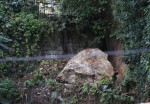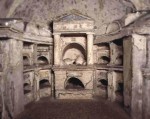 On the night of Tuesday, October 16th, 25-year-old bartender Mirko Curti left his apartment building at 196 Via di Pietralata in the Tiburtina neighborhood of Rome with his friend Raimondo Turnu in search of a missing cat. They heard meowing and followed the sound to an aperture that, due to heavy rains, had recently appeared in a low volcanic tufa cliff nearby. It was the entrance to a cave. Inside they found a number of human bones and a wall of niches called a columbarium which once held the ashes of Roman dead. “It was impressive,” said Curti. “I felt like an explorer. You go behind your house and you end up feeling like Indiana Jones.”
On the night of Tuesday, October 16th, 25-year-old bartender Mirko Curti left his apartment building at 196 Via di Pietralata in the Tiburtina neighborhood of Rome with his friend Raimondo Turnu in search of a missing cat. They heard meowing and followed the sound to an aperture that, due to heavy rains, had recently appeared in a low volcanic tufa cliff nearby. It was the entrance to a cave. Inside they found a number of human bones and a wall of niches called a columbarium which once held the ashes of Roman dead. “It was impressive,” said Curti. “I felt like an explorer. You go behind your house and you end up feeling like Indiana Jones.”
You might think this sort of thing happens all the time in a city as ancient and layered as Rome, but it really doesn’t, hence their elation. Tiburtina is within the current boundaries of the city, not in the historic center. It’s a relatively modern residential neighborhood, outside of the pomerium, the ancient sacred boundary that marked what was Rome and what was just land Rome owned. It was prime real estate for burials, though, since by law people could not be buried inside the pomerium. Plenty of archaeological finds have been made in the area (especially along the ancient Roman road), but you wouldn’t expect to stumble on one while looking for your cat behind your building.
 Despite their excitement at having stumbled onto an Indy moment of their own, the young men did the proper thing and left, calling the police to alert them to the find. (Sadly, there’s no word on whether they found the cat too.) The next day, the police called in various authorities, including municipal agents and firefighters, but first on the scene were archaeologists from the city Superintendence of Cultural Goods. Their preliminary findings indicate that the columbarium is of early Imperial date and was violated long ago. The human bones appear to have come from a higher level burial. They probably collapsed to their current location as a result of an earthquake or a landslide.
Despite their excitement at having stumbled onto an Indy moment of their own, the young men did the proper thing and left, calling the police to alert them to the find. (Sadly, there’s no word on whether they found the cat too.) The next day, the police called in various authorities, including municipal agents and firefighters, but first on the scene were archaeologists from the city Superintendence of Cultural Goods. Their preliminary findings indicate that the columbarium is of early Imperial date and was violated long ago. The human bones appear to have come from a higher level burial. They probably collapsed to their current location as a result of an earthquake or a landslide.
The area is susceptible to that kind of thing because tufa is very soft rock, which makes it easy to dig for necropolis purposes and makes it vulnerable to the elements. The ancients carved many caves into the Tiburtina cliffs, and recent rains caused stones and earth obscuring the large entrance of the cave to collapse. The city Superintendence has fenced off the cave entrance and closed off the small opening for now out of concern for public safety given the precariousness of the walls and roof of the structure.
 With the premises secured, now the state archaeologists are examining the contents. According to their assessment, the columbarium dates from the 1st century B.C. to the 2nd century A.D., an era when this style of burial was very popular among Romans of modest means. They would make monthly payments to a collegium, a burial society, which would then foot the bill for cremation, an urn and a dignified burial with all the proper rites in a communal columbarium for members and their families. More prosperous families would sometimes team up to share a columbarium, or one family would purchase one for themselves and sell any leftover spots to individuals.
With the premises secured, now the state archaeologists are examining the contents. According to their assessment, the columbarium dates from the 1st century B.C. to the 2nd century A.D., an era when this style of burial was very popular among Romans of modest means. They would make monthly payments to a collegium, a burial society, which would then foot the bill for cremation, an urn and a dignified burial with all the proper rites in a communal columbarium for members and their families. More prosperous families would sometimes team up to share a columbarium, or one family would purchase one for themselves and sell any leftover spots to individuals.
Because of the landslides, the recently discovered columbarium has a mound of earth obscuring most of the niches. When the cave is stabilized (which may be a while because Rome is expecting heavy rains in the upcoming days and weeks), archaeologists will excavate to reveal the full wall as well as recover the scattered bones. The finders estimate that there were at least 100 loose bones. Archaeologists expect that they will be of later date, although there could be overlap on the more recent end of the estimate. Inhumation was becoming increasingly fashionable by the second half of the 2nd century A.D. It would make cremation virtually obsolete by the fourth.
I do hope the kitty’s all right!
I never find cool stuff in my backyard! :angry:
Every time in spring, when I used to put away the blanket from our gardening equipment, I was confronted with a little columbarium full of dried little dead animals. I assume that our cat either deposited them deliberately, or they managed to escape under that blanked. Anyway… De mortuis nihil nisi bene 😀